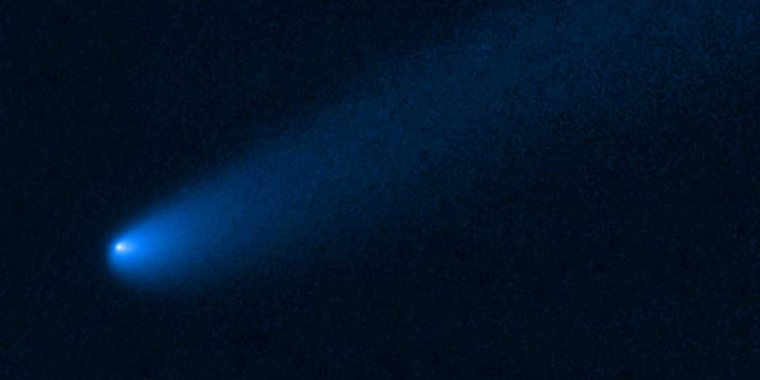| News / Space News |
Comet Makes a Pit Stop Near Jupiter’s Asteroids
After traveling several billion miles toward the Sun, a wayward young comet-like object orbiting among the giant planets has found a temporary parking place along the way. The object has settled near a family of captured ancient asteroids, called Trojans, that are orbiting the Sun alongside Jupiter.

NASA's Hubble Space Telescope snapped this image of the young comet P/2019 LD2 as it orbits near Jupiter’s captured ancient asteroids, which are called Trojans. The Hubble view reveals a 400,000-mile-long tail of dust and gas flowing from the wayward comet's bright solid nucleus. Photo: NASA/ESA/J. Olmsted/STScI
The unexpected visitor belongs to a class of icy bodies found in space between Jupiter and Neptune. Called Centaurs, they become active for the first time when heated as they approach the Sun, and dynamically transition into becoming more comet-like.
Visible-light snapshots by NASA’s Hubble Space Telescope reveal that the vagabond object shows signs of comet activity, such as a tail, outgassing in the form of jets, and an enshrouding coma of dust and gas.
Earlier observations by NASA’s Spitzer Space Telescope gave clues to the composition of the comet-like object and the gasses driving its activity.
“Only Hubble could detect active comet-like features this far away at such high detail, and the images clearly show these features, such as a roughly 400,000-mile-long broad tail and high-resolution features near the nucleus due to a coma and jets,” said lead Hubble researcher Bryce Bolin of Caltech in Pasadena, California.
Describing the Centaur’s capture as a rare event, Bolin added, “The visitor had to have come into the orbit of Jupiter at just the right trajectory to have this kind of configuration that gives it the appearance of sharing its orbit with the planet. We’re investigating how it was captured by Jupiter and landed among the Trojans. But we think it could be related to the fact that it had a somewhat close encounter with Jupiter.”
The research team’s computer simulations show that the icy object, called P/2019 LD2 (LD2), probably swung close to Jupiter about two years ago. The planet then gravitationally punted the wayward visitor to the Trojan asteroid group’s co-orbital location, leading Jupiter by about 437 million miles.
The nomadic object was discovered in early June 2019 by the University of Hawaii’s Asteroid Terrestrial-impact Last Alert System (ATLAS) telescopes located on the extinct volcanoes, one on Mauna Kea and one on Haleakala.
Although LD2’s location is surprising, Bolin wonders whether this pit stop could be a common pull-off for some sunward-bound comets. “This could be part of the pathway from our solar system through the Jupiter Trojans to the inner solar system,” he said.
The unexpected guest probably will not stay among the asteroids for very long. Computer simulations show that it will have another close encounter with Jupiter in about another two years. The hefty planet will boot the comet from the system, and it will continue its journey to the inner solar system.
Jupiter controls what’s going on with comets once they get into the inner system by altering their orbits.
The icy interloper is most likely one of the latest members of the so-called “bucket brigade” of comets to get kicked out of its frigid home in the Kuiper Belt and into the giant planet region through interactions with another Kuiper Belt object.
Located beyond Neptune’s orbit, the Kuiper Belt is a haven of icy, leftover debris from our planets’ construction 4.6 billion years ago, containing millions of objects, and occasionally these objects have near misses or collisions that drastically alter their orbits from the Kuiper Belt inward into the giant planet region.
The bucket brigade of icy relics endure a bumpy ride during their journey sunward. They bounce gravitationally from one outer planet to the next in a game of celestial pinball before reaching the inner solar system, warming up as they come closer to the Sun.
The researchers say the objects spend as much or even more time around the giant planets, which are gravitationally pulling on them – about 5 million years – than they do crossing into the inner system where we live.
“Inner-system, ‘short-period’ comets break up about once a century,” Carey Lisse of the Johns Hopkins University Applied Physics Laboratory (APL) in Laurel, Maryland explained. “So, in order to maintain the number of local comets we see today, we think the bucket brigade has to deliver a new short-period comet about once every 100 years.”
Water remains frozen on a comet until it reaches about 200 million miles from the Sun, where heat from sunlight converts water ice to gas that escapes from the nucleus in the form of jets. So the activity signals that the tail might not be made of water.
In fact, observations by Spitzer indicated the presence of carbon monoxide and carbon dioxide gas, which could be driving the creation of the tail and jets seen on the Jupiter-orbiting comet. These volatiles do not need much sunlight to heat their frozen form and convert them to gas.
Once the comet gets kicked out of Jupiter’s orbit and continues its journey, it may meet up with the giant planet again. “Short-period comets like LD2 meet their fate by being thrown into the Sun and totally disintegrating, hitting a planet, or venturing too close to Jupiter once again and getting thrown out of the solar system, which is the usual fate,” Lisse said. “Simulations show that in about 500,000 years, there’s a 90% probability that this object will be ejected from the solar system and become an interstellar comet.” (NASA)
YOU MAY ALSO LIKE





